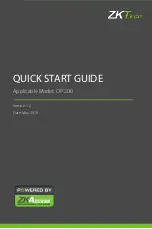
OPERATING INSTRUCTIONS
1.
Lift the vehicle to the desired work height and support the
vehicle in accordance with the manufacturer’s recommended
support procedure and the warnings given in this manual.
2.
Follow the manufacturer’s recommended service procedure for
removing and installing the component.
3.
When removing a transmission, use an under hoist stand rated
greater than the weight of the engine to support the engine before
unbolting the transmission from the engine.
4.
Position the lift table directly under the component to be lifted.
Connect shop air supply to the air/hydraulic foot pump (use
minimum 90 P.S.I. air pressure, do not exceed 120 P.S.I.).
5.
IMPORTANT: Become familiar with the pedal operation of
the air/hydraulic foot pump before using the lift table under load.
Depressing the foot pedal end marked “Pump” raises the lift table
saddle. To raise the saddle a small distance it is necessary to use
incremental taps of your foot on the foot pedal until the saddle
reaches the desired height. Lowering the saddle is accomplished
by depressing the foot pedal end marked “Release”. The pump is
equipped with a two speed release mechanism. Gently depressing
the foot pedal end marked “Release” lowers the jack slower than
if you depress the pedal all the way down. If you want to lower the
load slower than the slow speed release, use gentle incremental
taps of your foot on the “Release” pedal.
6.
Depress the air/hydraulic pump foot pedal marked “Pump” to
raise the lift table saddle to a height very close to the center of
balance point of the component but do not touch it.
7.
If using the universal table, adjust the blocks to fit the
component configuration. Secure the blocks to the universal
table by tightening the bolts provided. If using the transmission
adapters, adjust the support arms or position the risers to fit the
oil pan flange configuration. Tighten the hardware that secures the
support arms to the adapter. If using the fuel tank saddle, adjust
the pads to support the tank and tighten the hardware that secures
the pads to the saddle.
8.
Turn the side to side and fore and aft tilt knobs to align the
saddles or adapters with the component lift surface. Now gently
raise the lift table saddle or adapters to support the component.
9.
Use the restraint chains or tie downs to secure the components
to the saddle or adapter. Make sure the setup is stable before
lowering the load.
10.
To lower the load, very gently depress the air/hydraulic foot
pump pedal marked “Release” and make sure the lift table’s saddle
and component (load) do not hang up on any other undercar
or undertruck components, wiring, fuel lines, brake lines, etc.
Continue to lower the component all the way down.
11.
Follow the vehicle manufacturer’s recommended service
procedure and this manual’s operating instructions when
reinstalling the component.
REPAIR SERVICE
If your Norco product requires service or repair, contact the Norco
Customer Service Department for the location of the nearest Norco
Authorized Service Center.
Norco Industries, Inc.
365 West Victoria St.
Compton, CA 90220
(310) 639-4000 • Fax: (310) 639-7411
www.norcoindustries.com
It will be necessary to provide the Norco Authorized Service Center
with a copy of the bill of sale if requesting warranty repair. If the
authorized service center determines your product is eligible for
warranty repair, the repair will be made at no charge and returned
freight prepaid. The cost of non-warrantable service, repair, and
return freight is the customer’s responsibility.
1.
Always store the lift table in a well protected area where it will
not be exposed to inclement weather, corrosive vapors, abrasive
dust, or any other harmful elements. The lift table must be cleaned
of water, snow, sand, or grit before using.
2.
Lubricate moving parts once a month with a general purpose
grease. Inspect all lift arms, saddle base and cylinder assemblies
to make sure all related bolts and nyloc nuts are tight but do not
restrict the movement of assembly components that rotate on the
bolts.
3.
It should not be necessary to refill or top off the reservoir with
hydraulic fluid unless there is an external leak. An external leak
requires immediate repair which must be performed in a dirt-
free environment by qualified hydraulic repair personnel who are
familiar with this equipment. Norco Authorized Service Centers are
recommended.
IMPORTANT: In order to prevent seal damage
and lift table failure, never use alcohol, hydraulic brake fluid,
or transmission oil in the lift table’s hydraulic ram or air/
hydraulic foot pump.
4.
Every lift table owner is responsible for keeping the lift table
label clean and readable. Use a mild soap solution to wash external
surfaces of the lift table but not any moving hydraulic components.
Contact Norco Industries for a replacement label if your jack’s label
is unreadable.
5.
Inspect the lift table before each use. Do not use the lift table if
any component is cracked, broken, bent, shows sign of damage,
or leaks hydraulic fluid. Do not use the lift table if it has loose or
missing hardware or components, or is modified in any way. Take
corrective action before using the lift table again.
6.
Do not attempt to make any hydraulic repairs unless you
are a qualified hydraulic repair person that is familiar with this
equipment.
PREVENTATIVE MAINTENANCE
72675




















